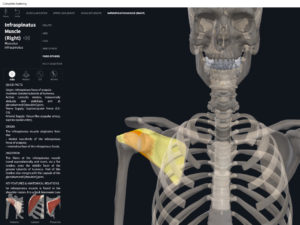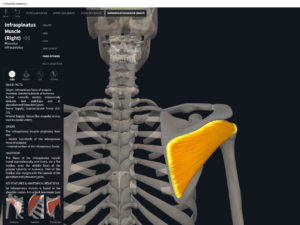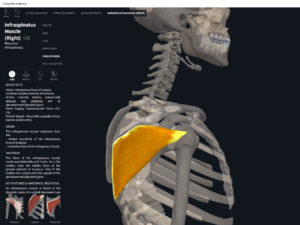Anatomy & Physiology: Muscles—Infraspinatus.
Structure.
- Origin: infraspinous fossa of scapula.
- Insertion: middle facet of greater tubercle of humerus.
Function.
- Concentric action: shoulder external/lateral rotation and adduction. Horizontal extension of arm.
- Reverse mover action: lateral tilt of scapula.
- Eccentric action: shoulder internal rotation; horizontal flexion; controls/restrains/slows scapular medial tilt.
- Isometric action: stabilization of the shoulder girdle.
- Innervation: suprascapular nerve.
- Arterial supply: suprascapular artery; circumflex scapular artery.
Clinical Significance.
More.
- https://www.anatomynext.com/infraspinatus/
- https://www.youtube.com/watch?v=vopMuDGPFEU
- https://www.youtube.com/watch?v=SLJYGo60IbI
- https://www.youtube.com/watch?v=_tmj5-9QBAo
References
Biel, A. (2015). Trail guide to the body: A hands-on guide to locating muscles, bones and more.
Cedars-Sinai. (2018). Vertebrae of the spine. Retrieved from https://www.cedars-sinai.org/health-library/diseases-and-conditions/v/vertebrae-of-the-spine.html
Clark, M., Lucett, S., Sutton, B. G., & National Academy of Sports Medicine. (2014). NASM essentials of corrective exercise training. Burlington, MA: Jones & Bartlett Learning.
Jenkins, G., & Tortora, G. J. (2012). Anatomy and Physiology: From Science to Life, 3rd Edition International Stu. John Wiley & Sons.
Muscolino, J. E. (2017). The muscular system manual: The skeletal muscles of the human body.



